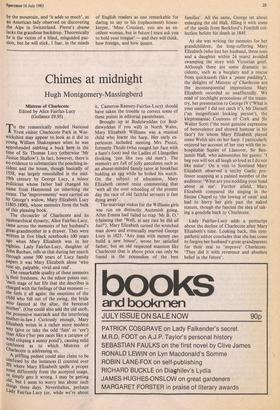Chimes at midnight
Hugh Montgomery-Massingberd
Mistress of Charlecote Edited by Alice Fairfax-Lucy (Gollancz £9,95)
To the romantically minded National Trust visitor Charlecote Park in War- wickshire may appear to look as it did to Young William Shakespeare when he was apprehended nabbing a buck here in the time of Sir Thomas Lucy (otherwise `Mr Justice Shallow'). In fact, however, there is no evidence to substantiate the poaching in- cident and the house, though basically of 1558, was largely remodelled in the mid- 19th century by George Lucy, a minor Politician whose father had changed his name from Hammond on inheriting the estate. The 'improvements' were carried on by George's widow, Mary Elizabeth Lucy (1803-1890), whose memoirs form the bulk of this pleasing book.
The chronicler of Charlecote and its squirearchical dynasty, Alice Fairfax-Lucy, came across the memoirs of her husband's great-grandmother in a drawer. They were written in five black notebooks 100 years ago when Mary Elizabeth was in her eighties. Lady Fairfax-Lucy, daughter of John Buchan, tells us that during her search through some 500 years of Lucy family Papers it was Mary Elizabeth alone 'who rose up, palpable, vivid and real'.
The remarkable quality of these memoirs !i their freshness. As the editor points out: each stage of her life that she describes is Charged with the feelings of that moment she feels it all again: the emotions of the child who fell out of the swing, the bride Who fainted at the altar, the bereaved Mother'. (One could also add the old snob, the possessive matriach and the interfering mother-in-law.) Curiously enough, Mary Elizabeth writes in a rather more modern Way (give or take the odd 'fain' or 'ere') than Alice Cher pen races like a catspaw of wind crisping a sunny pond'), causing mild confusion as to which Mistress of Charlecote is addressing us. A piffling pedant could also claim to be confused by the instances (I counted over 20) where Mary Elizabeth spells a proper noun differently from the accepted usage, Or simply gets it wrong. I may be getting , but I seem to worry less about such ,t1tiligs these days. Nevertheless, perhaps LadY Fairfax-Lucy (or, while we're about
it, Cameron-Ramsey-Fairfax-Lucy) should have taken the trouble to correct some of these points in editorial parentheses.
Brought up at Bodelwyddan (or Bod- dlewyddan if you will) in North Wales, Mary Elizabeth Williams was a musical child who, learnt the harp. Her early ex- periences included meeting Mrs Piozzi, formerly Thrale (who rouged her face with a hare's foot) and the Ladies of Llangollen (looking 'just like two old men'). The memoirs are full of jolly anecdotes such as an absent-minded family tutor at breakfast holding an egg while he boiled his watch. On the subject of education, Mary Elizabeth cannot resist commenting that `with all the over schooling of the present day the race of old faithful servants is fast dying away'.
The marriage stakes for the Williams girls was run on distinctly Austenish going. After Emma had failed to trap `Mr B. 02 (claiming that `Well, at any rate he did all but!'), Mary Elizabeth turned the wretched man down and eventually married George Lucy in 1823. 'Any man with money can build a new house', wrote her satisfied father, but an old respected mansion like Charlecote that is above price can only be found in the possession of the best
families'. All the same, George set about enlarging the old Hall, filling it with some of the spoils from Beckford's Fonthill col- lection before his death in 1845.
As she was writing the memoirs for her grandchildren, the long-suffering Mary Elizabeth (who lost her husband, three sons and a daughter within 24 years) avoided swamping the story with Victorian grief. Although there are some dramatic in- cidents, such as a burglary and a rescue from quicksands (like a 'pease pudding'), the delights of Mistress of Charlecote are the inconsequential impressions Mary Elizabeth recorded so unaffectedly. We read of torchlight processions of the tenan- try, her presentation to George IV ('What is your name? I did not catch it'), Mr Disraeli Can insignificant looking person'), the kleptomaniac Countess of Cork and Sir Walter Scott ('the most genuine expression of benevolence and shrewd humour in his face') for whom Mary Elizabeth played some Welsh airs on her harp. I particularly enjoyed her account of her stay with the in- hospitable Squire of Llanover, Sir Ben- jamin Hall, who admonishes his guests: 'I beg you will not all laugh so loud as I do not like noise'. On a visit to Scotland Mary Elizabeth observed a tetchy Gaelic pro- fessor snapping at a palsied member of the audience: 'What are you nodding your head about at me'. Further afield, Mary Elizabeth compared the singing in the Sistine Chapel to 'the lowing of oxen' and had to hurry her girls past the naked statues, though she fancied the idea of tak- ing a gondola back to Charlecote.
Lady Fairfax-Lucy adds a postscript about the decline of Charlecote after Mary Elizabeth's time. Looking back, this sym- pathetic editor concludes that she has come to forgive her husband's great-grandparents for their zeal to 'improve' Charlecote. 'They did it with reverence and absolute belief in the future'.






































 Previous page
Previous page